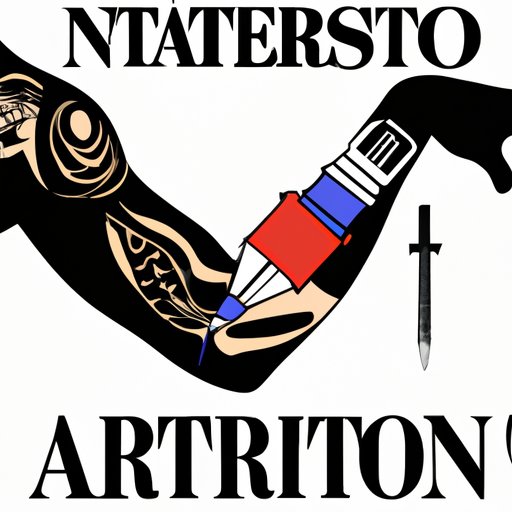Introduction
Tattoo artists are highly skilled individuals who create beautiful, unique works of art on the human body. Becoming a tattoo artist requires dedication and commitment, as it is not an easy process. However, with the right guidance and knowledge, anyone can become a successful tattoo artist.
In this article, we will explore what it takes to become a tattoo artist. We will cover the necessary research qualifications and licensing requirements, taking courses in art and graphic design, understanding health and safety regulations for tattooing, practicing on fake skin, networking with experienced tattoo artists, and marketing yourself as a tattoo artist.

Research Qualifications and Licensing Requirements Needed to Become a Tattoo Artist
The first step in becoming a tattoo artist is to research the qualifications and licensing requirements for your area. While some areas may have different regulations than others, there are certain requirements that must be met in order to legally practice tattooing.
Find Out About Local Regulations
It is important to understand the laws and regulations in your area when it comes to tattooing. Different states have different rules and regulations regarding tattooing, so it is important to do your research and make sure you are following all local laws. You can find out more information by contacting your local health department or state board of health.
Understand What Qualifications Are Necessary
In addition to finding out about local regulations, you should also understand what qualifications are necessary to become a tattoo artist. Generally speaking, most states require tattoo artists to be at least 18 years old and have a high school diploma or equivalent. Depending on the state, additional qualifications may also be required.
Look for Licensing Requirements
Most states also require tattoo artists to obtain a license before they can legally practice tattooing. The requirements for obtaining a license vary from state to state, but typically include passing a written exam and completing an approved apprenticeship program. You can find out more information about licensing requirements in your state by visiting the website of your state’s Board of Health.

Take Courses in Art and Graphic Design
In order to become a successful tattoo artist, it is important to have a strong foundation in art and graphic design. Taking courses in these subjects can help you develop the skills and knowledge necessary to create beautiful tattoos.
Learn the Basics of Drawing
The first step in learning how to draw is to master the basics. Start by practicing basic shapes such as circles, triangles, and squares. Once you have mastered the basics, you can move on to more complex shapes and forms. Additionally, you should practice drawing from life, using reference photos or images as guides.
Develop Your Skills in Color Theory
Color theory is an essential part of creating beautiful tattoos. Take time to learn about the color wheel, color harmony, and how different colors interact with one another. Understanding color theory will help you create tattoos that are visually appealing and balanced.
Practice Working with Different Materials
In addition to mastering the basics of drawing and color theory, it is also important to practice working with different materials. This includes learning how to use different types of inks, needles, and machines. Practicing with different materials will help you become comfortable with the tools of the trade and ensure that your tattoos look their best.
Learn About Health and Safety Regulations for Tattooing
In order to practice tattooing safely and responsibly, it is important to understand the health and safety regulations related to tattooing. These regulations are in place to protect both the tattoo artist and the client, and it is important to follow them at all times.
Understand the Risks Involved with Tattooing
Tattooing carries certain risks, such as infection and allergic reactions. It is important to understand these risks and take steps to minimize them, such as wearing gloves, using sterile equipment, and following proper aftercare instructions. In addition, it is important to be aware of any potential medical conditions that could put a client at risk, such as diabetes or a weakened immune system.
Know How to Properly Clean and Sterilize Equipment
It is also important to understand how to properly clean and sterilize tattoo equipment. This includes cleaning the equipment between clients, using only sterile needles, and disposing of used needles properly. Following proper sanitation protocols is essential for preventing the spread of disease.
Familiarize Yourself with Blood-borne Pathogens
Tattooing involves coming into contact with blood and other bodily fluids, which can carry blood-borne pathogens such as HIV and hepatitis. It is important to understand how to prevent the spread of these diseases, such as wearing protective gear and following proper sanitization protocols. Additionally, it is important to understand the symptoms of these diseases and know what to do if a client shows any signs of illness.
Practice on Fake Skin or Fruit Before Tattooing Human Skin
Before you start tattooing real people, it is important to practice on fake skin or fruits. This will help you perfect your technique and gain confidence in your skills. It is also a great way to experiment with different designs and techniques without having to worry about making mistakes on real skin.
Understand the Difference between Real Skin and Fake Skin
Real skin and fake skin are very different, and it is important to understand the differences between the two. Real skin is much softer and more delicate than fake skin, so it is important to adjust your technique accordingly. Additionally, real skin will bleed and bruise more easily than fake skin, so it is important to be gentle and use light strokes.
Practice on Fake Skin to Perfect Your Technique
Using fake skin is a great way to practice your technique and build your confidence. You can purchase fake skin from most tattoo supply stores, or you can make your own using materials such as latex, wax, and clay. Practice drawing simple designs and experimenting with different techniques until you feel comfortable enough to move on to real skin.
Use Fruits and Vegetables as a Substitute for Fake Skin
If you don’t have access to fake skin, you can use fruits and vegetables as a substitute. Bananas, apples, and potatoes are all good choices for practicing on, as they have a similar texture to real skin. Be sure to use a fresh piece of fruit or vegetable each time you practice, as the ink can stain the skin and make it difficult to clean.
Network with Experienced Tattoo Artists
Networking with experienced tattoo artists is a great way to learn more about the craft and gain valuable insights. It is also a great way to get your name out there and make connections in the industry.
Reach Out to Local Tattoo Shops
Start by reaching out to local tattoo shops and asking if they are hiring or looking for apprentices. Many shops are willing to take on new artists and provide mentorship, so don’t be afraid to ask. Additionally, many shops have open house events where you can meet the staff and show off your portfolio.
Follow Experienced Tattoo Artists on Social Media
Social media is a great way to connect with experienced tattoo artists and learn from them. Follow your favorite artists on Instagram, Twitter, and Facebook and engage with them by commenting on their posts and asking questions.
Ask Questions and Learn from Experienced Tattoo Artists
Once you have connected with experienced tattoo artists, don’t be afraid to ask questions. Most experienced artists are more than happy to share their knowledge and help out aspiring tattooists. Ask about their experiences, techniques, and advice on how to become a successful tattoo artist.

Market Yourself as a Tattoo Artist
Once you have mastered the fundamentals of tattooing, it is time to start marketing yourself as a tattoo artist. This includes creating a professional portfolio, building a website or social media presence, and participating in tattoo conventions and competitions.
Create a Professional Portfolio
Creating a professional portfolio is essential for showcasing your work and attracting clients. Put together a collection of your best tattoos and display it on your website or social media pages. Additionally, you can create physical copies of your portfolio to bring to conventions and competitions.
Build a Website or Social Media Presence
Having a website or social media presence is a great way to reach potential clients and show off your work. Create a website or social media pages and post updates regularly. You can also use these platforms to promote special offers, advertise your services, and connect with other tattoo artists.
Participate in Tattoo Conventions and Competitions
Participating in tattoo conventions and competitions is a great way to network with other tattoo artists and showcase your work. Look for conventions and competitions in your area and submit your portfolio for consideration. This is a great way to get your name out there and make connections in the industry.
Conclusion
Becoming a tattoo artist is no easy feat, but with the right guidance and dedication, anyone can become a successful tattoo artist. The process involves researching qualifications and licensing requirements, taking courses in art and graphic design, understanding health and safety regulations for tattooing, practicing on fake skin or fruits, networking with experienced tattoo artists, and marketing yourself as a tattoo artist. With hard work and dedication, you can become a successful tattoo artist and create beautiful, unique works of art.
(Note: Is this article not meeting your expectations? Do you have knowledge or insights to share? Unlock new opportunities and expand your reach by joining our authors team. Click Registration to join us and share your expertise with our readers.)
